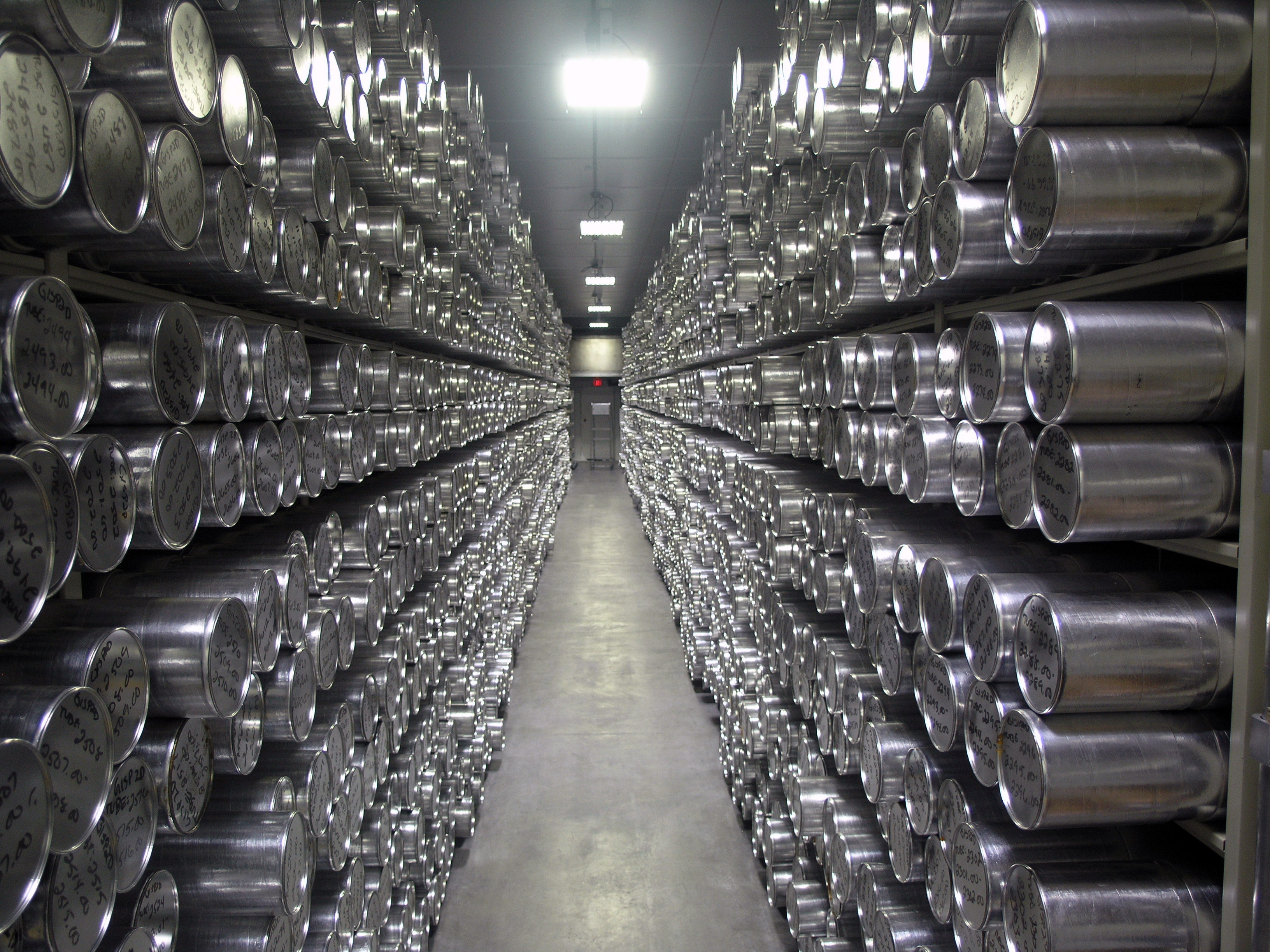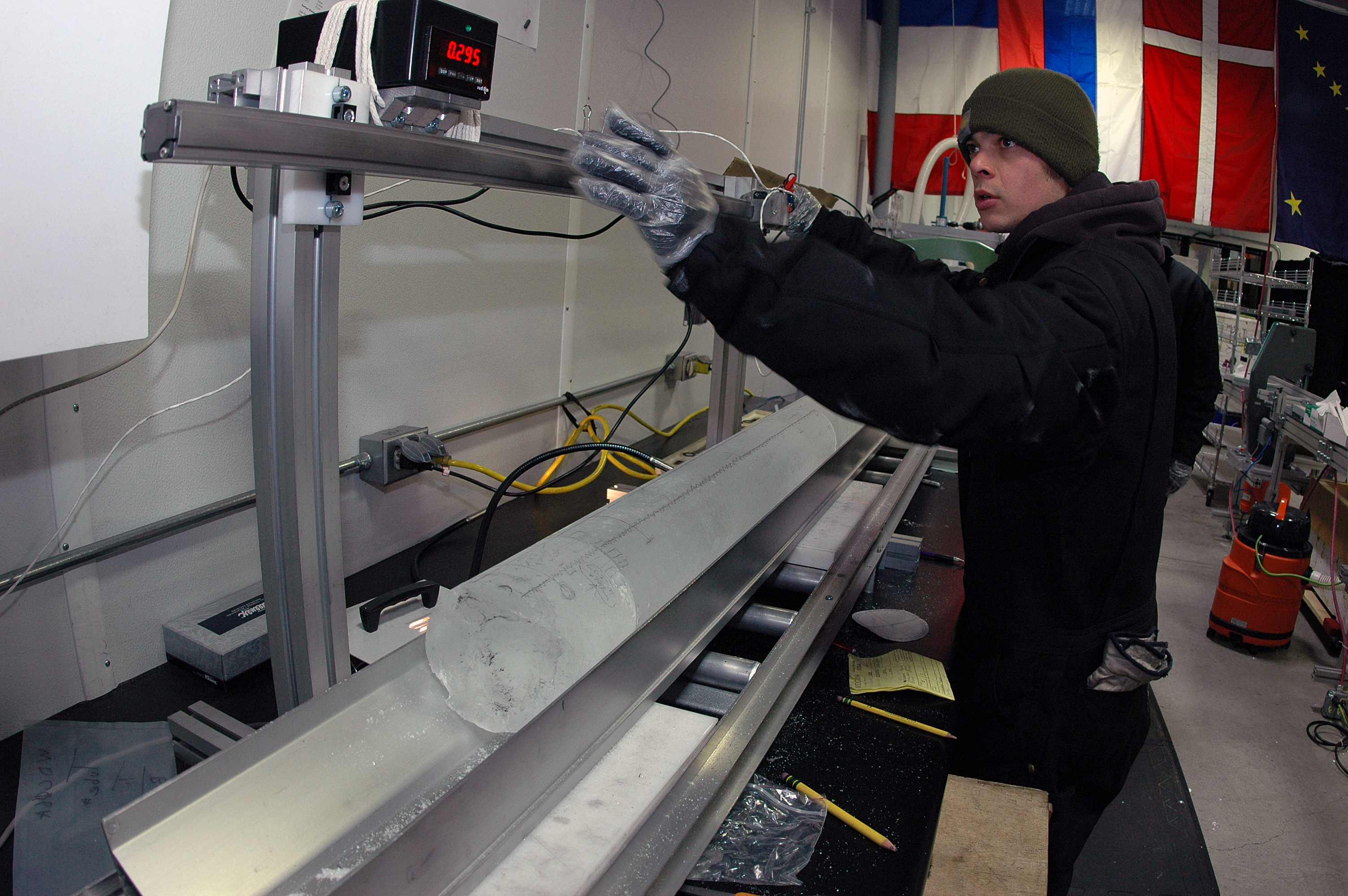
The National Science Foundation (NSF) has supported U.S. ice core facilities for storing, curating, and studying meteoric ice cores recovered from the glaciated regions of the world for over four decades. These facilities provide scientists with the capability to conduct examinations and measurements on ice cores, and preserve the integrity of these ice cores, in a long-term repository for current and future investigations.
The current U.S. ice core facility is the National Ice Core Laboratory (NICL). NICL was established in 1993 and is located in Building 810 of the Denver Federal Center in Lakewood, Colorado. NICL is funded by the NSF and housed administratively within the U.S. Geological Survey, Core Science Systems Mission Area, which is responsible for all operational aspects of the facility.
The NICL's most important responsibility is for the safe and secure storage and curation of ice cores that are collected primarily by NSF-sponsored projects. The facility also provides a venue for scientists to examine ice cores without having to travel to remote field sites. The main archive freezer is 55,000 cubic feet in size and is held at a temperature of -36°C. The exam room, held at -24°C, is 12,000 cubic feet in size, contiguous with the archive area, and contains a filtered cold air room and a +3°C loading dock. The NICL also consists of space outside the freezer facility for material fabrication, storage, changing areas, offices, and visiting scientist workspace.
NICL currently uses the hydrochlorofluorocarbon (HCFC) HCFC-22, commonly referred to as R-22, as the refrigerant to keep the freezer cold. Under the U.S. Clean Air Act and the Montreal Protocol on Substances that Deplete the Ozone Layer, the U.S. is phasing out the production and import of HCFCs in order to protect the stratospheric ozone layer. Starting on January 1, 2020, U.S. production and import of HCFC-22 will end. While the use of HCFC-22 can still continue after January 1, 2020, the supply of HCFC-22 will be extremely low and its cost will be extremely high.
In late 2013, the NSF Division of Polar Programs asked Dr. Robert W. Corell to develop a study team to review and develop recommendations and options for the future of NICL that meet existing and future national and international refrigeration system policies mandated by the U.S. as a signatory of the Montreal Protocol. The central mandate of the NICL Long Range Sustainability Plan study is to assess the current NICL refrigeration system, and to recommend options for the future of NICL that meet the refrigeration requirements of the Montreal Protocol.
The NICL Long Range Sustainability Plan contains three sections:
Section 1: A detailed analysis of the science projected for the decades ahead that will require support by the NICL facility.
Section 2: An analysis of the NICL facility science requirements, and an engineering study of a proposed upgrade to NICL's refrigeration system. The engineering study will address the design, costs, projected time schedules, and other technical and engineering details of the facility.
There are three scenarios under consideration regarding the refrigeration upgrade:
- Temporarily move NICL's cores to a commercial storage facility, update the refrigeration in the current NICL facility, and return the cores to the updated NICL facility;
- Build an additional storage freezer at NICL, move the cores to the new storage freezer, update the refrigeration in the current NICL facility, and then return appropriate cores to updated NICL facility;
- Build a new ice core facility at a location to-be-determined, move the cores at NICL to the new facility, and decommission NICL.
In order to proceed with the three scenarios above, NICL-SMO has worked with the ice core science community to develop science requirements for a U.S. Ice Core Facility (see below).
Section 3: A review of NICL's existing management and organizational plan, and a recommendation on how to run the facility in the coming years.
It is envisioned that the recommendations and options outlined in the NICL Long Range Sustainability Plan will serve as the basis for the NSF to develop the necessary program and budgetary needs to upgrade NICL's refrigeration and accompanying NICL facilities for the decades ahead.

Science Requirements for a U.S. Ice Core Facility
General Requirements
- Geographically located in an area easily accessible by commercial aircraft and not more than 1 hour (or 60 miles) from the airport.
- The Facility should be dedicated to only the storage of meteoric ice samples.
- Redundant cooling/freezing system components (e.g., 100% redundancy in compressors, evaporators and condensers).
- Dedicated alarm system for power, temperature, mechanical systems and air monitoring with back-up power generation, preferably natural gas fueled.
- Metered power supply.
- Constructed or updated using the latest in energy efficient technology (including interior lighting and under-floor heating using waste heat generated by the cooling system).
- Facility should be inside an envelope building to provide additional security and safety.
Main Archive Freezer
- Provide for long-term archive storage of meteoric ice cores and is sustained for at least the next 25 years.
- Ability to accommodate an additional 15,000 meters of ice cores (nominally 4 inches in diameter) over the next 25 years.
- Maintain temperatures to minimize sublimation and to preserve the integrity of compounds in ice cores. NICL currently maintains -36°C in the archive freezer.
- Provide access to all ice cores in the main archive freezer (i.e. individual ice cores can be directly accessed).
- Adjustable shelving to accommodate different sized core tubes.
- Accommodate long-term archival storage of ice cores up to 14 cm diameter in the main archive freezer and up to 24 cm diameter for short term storage.
- Allow for de-accession of ice cores from the main archive freezer.
Exam Room
- Maintain temperatures to minimize sublimation and to preserve the integrity of compounds in the ice cores. NICL currently maintains a temperature of -24°C in the exam room.
- Provide flexible work area that can be adjusted to accommodate the needs of the investigator or multiple investigators sub-sampling ice core.
- Exam room contiguous to main archive freezer.
- Exam room should have pre-chilled makeup air so that the room has a continuous supply of cold fresh air; exhausted air should be discharged to outside the envelope building.
Loading Dock
- Maintain cool loading dock for large shipments of ice cores and preparing shipment of individual shipments.
Physical Space Outside Freezer Facility
- Availability of adequate space for material fabrication, storage, changing areas, offices, and visiting scientist workspace.
Staff
- Provide curators with experience in organizing and assisting core processing sessions, sampling, database maintenance, and training of investigators and students.
- Provide Internet access to the digital archive sample availability database.
Facility Desires
- Hi-density roller racking to maximize storage.
- Ability to bring the dock area temperature down to -20°C for temporary storage of large shipments of ice.

